 Video:
00:04:30
Video:
00:04:30
Explore the immense power of water as ESA’s Mars Express takes us on a flight over curving channels, streamlined islands and muddled ‘chaotic terrain’ on Mars, soaking up rover landing sites along the way.
This beautiful flight around the Oxia Palus region of Mars covers a total area of approximately 890 000 km², more than twice the size of Germany. Central to the tour is one of Mars’s largest outflow channels, Ares Vallis. It stretches for more than 1700 km and cascades down from the planet’s southern highlands to enter the lower-lying plains of Chryse Planitia.
Billions of years ago, water surged through Ares Vallis, neighbouring Tiu Vallis, and numerous other smaller channels, creating many of the features observed in this region today.
Enjoy the flight!
After enjoying a spectacular global view of Mars we focus in on the area marked by the white rectangle. Our flight starts over the landing site of NASA’s Pathfinder mission, whose Sojourner rover explored the floodplains of Ares Vallis for 12 weeks in 1997.
Continuing to the south, we pass over two large craters named Masursky and Sagan. The partially eroded crater rim of Masursky in particular suggests that water once flowed through it, from nearby Tiu Vallis.
The Masurky Crater is filled with jumbled blocks, and you can see many more as we turn north to Hydaspis Chaos. This ‘chaotic terrain’ is typical of regions influenced by massive outflow channels. Its distinctive muddled appearance is thought to arise when subsurface water is suddenly released from underground to the surface. The resulting loss of support from below causes the surface to slump and break into blocks of various sizes and shapes.
Just beyond this chaotic array of blocks is Galilaei crater, which has a highly eroded rim and a gorge carved between the crater and neighbouring channel. It is likely that the crater once contained a lake, which flooded out into the surroundings. Continuing on, we see streamlined islands and terraced river banks, the teardrop-shaped island ‘tails’ pointing in the downstream direction of the water flow at the time.
Crossing over Ares Vallis again, the flight brings us to the smoother terrain of Oxia Planum and the planned landing site for ESA’s ExoMars Rosalind Franklin rover. The primary goal of the mission is to search for signs of past or present life on Mars, and as such, this once water-flooded region is an ideal location.
Zooming out, the flight ends with a stunning bird’s-eye view of Ares Vallis and its fascinating water-enriched neighbourhood.
Disclaimer: This video is not representative of how Mars Express flies over the surface of Mars. See processing notes below.
How the movie was made
This film was created using the Mars Express High Resolution Stereo Camera Mars Chart (HMC30) data, an image mosaic made from single orbit observations of the High Resolution Stereo Camera (HRSC). The mosaic, centred at 12°N/330°E, is combined with topography information from the digital terrain model to generate a three-dimensional landscape.
For every second of the movie, 50 separate frames are rendered following a predefined camera path in the scene. A three-fold vertical exaggeration has been applied. Atmospheric effects such as clouds and haze have been added to conceal the limits of the terrain model. The haze starts building up at a distance of 300 km.
The HRSC camera on Mars Express is operated by the German Aerospace Center (DLR). The systematic processing of the camera data took place at the DLR Institute for Planetary Research in Berlin-Adlershof. The working group of Planetary Science and Remote Sensing at Freie Universität Berlin used the data to create the film.

Zoom into Solar Orbiter's four new Sun images, assembled from high-resolution observations by the spacecraft's PHI and EUI instruments made on 22 March 2023. The PHI images are the highest-resolution full views of the Sun's visible surface to date, including maps of the Sun's messy magnetic field and movement on the surface. These can be compared to the new EUI image, which reveals the Sun's glowing outer atmosphere, or corona.
 Video:
00:06:45
Video:
00:06:45
Smile is the Solar wind Magnetosphere Ionosphere Link Explorer, a brand-new space mission currently in the making. It will study space weather and the interaction between the solar wind and Earth’s environment.
Unique about Smile is that it will take the first X-ray images and videos of the solar wind slamming into Earth’s protective magnetic bubble, and its complementary ultraviolet images will provide the longest-ever continuous look at the northern lights.
In this first of several short videos, David Agnolon (Smile Project Manager) and Philippe Escoubet (Smile Project Scientist) talk about the why and the how of Smile. You’ll see scenes of the building and testing of the spacecraft’s payload module by Airbus in Madrid, including the installation of one of the European instruments, the Soft X-ray Imager from the University of Leicester.
Smile is a 50–50 collaboration between the European Space Agency (ESA) and the Chinese Academy of Sciences (CAS). ESA provides the payload module of the spacecraft, which carries three of the four science instruments, and the Vega-C rocket which will launch Smile to space. CAS provides the platform module hosting the fourth science instrument, as well as the service and propulsion modules.
 Video:
00:09:09
Video:
00:09:09
On 12 November 2014, after a ten-year journey through the Solar System and over 500 million kilometres from home, Rosetta’s lander Philae made space exploration history by touching down on a comet for the first time. On the occasion of the tenth anniversary of this extraordinary feat, we celebrate by taking a look back over the mission's highlights.
Rosetta was an ESA mission with contributions from its Member States and NASA. It studied Comet 67P/Churyumov-Gerasimenko for over two years, including delivering lander Philae to the comet’s surface. Philae was provided by a consortium led by DLR, MPS, CNES and ASI.
Read the article Philae’s extraordinary comet landing relived.
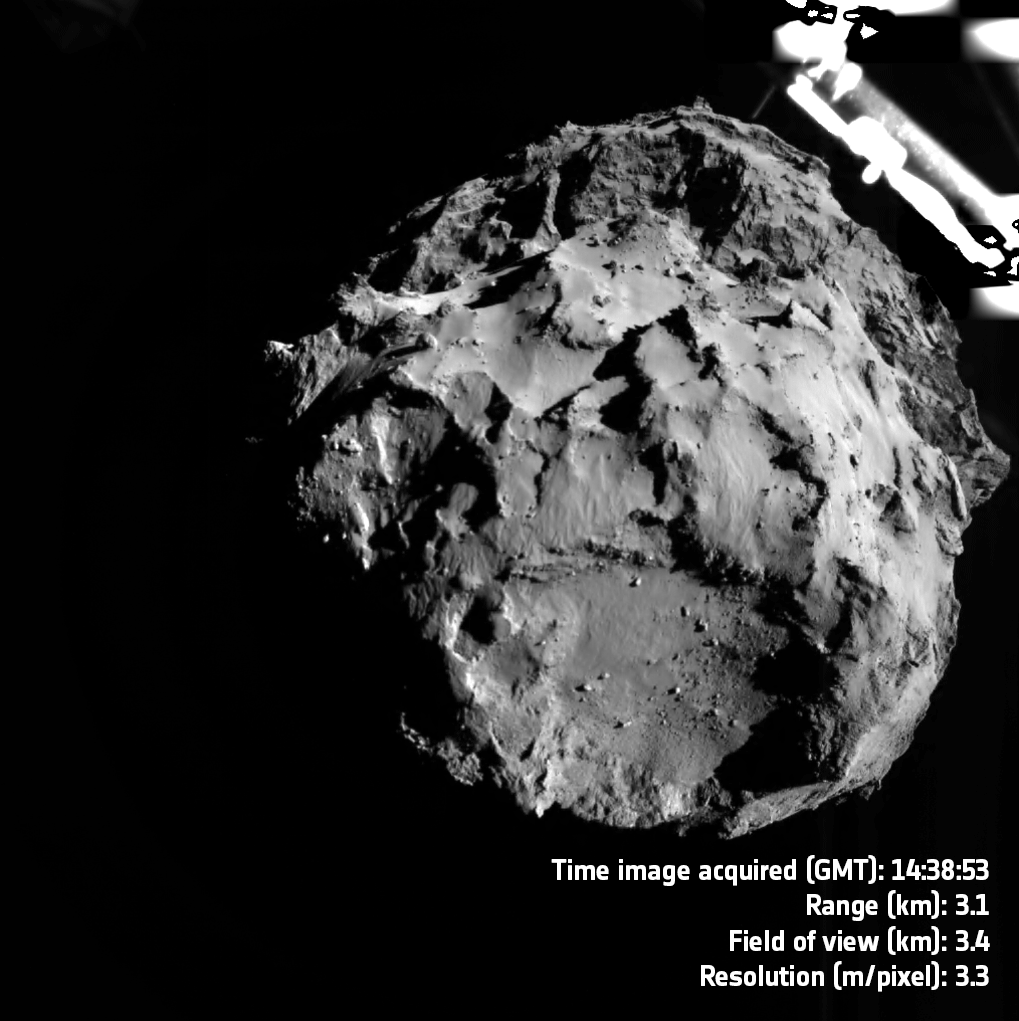
On 12 November 2014, after a ten year journey through the Solar System and over 500 million kilometres from home, Rosetta’s lander Philae made space exploration history by touching down on a comet for the first time. On the occasion of the tenth anniversary of this extraordinary feat, we celebrate Philae’s impressive achievements at Comet 67P/Churyumov-Gerasimenko.
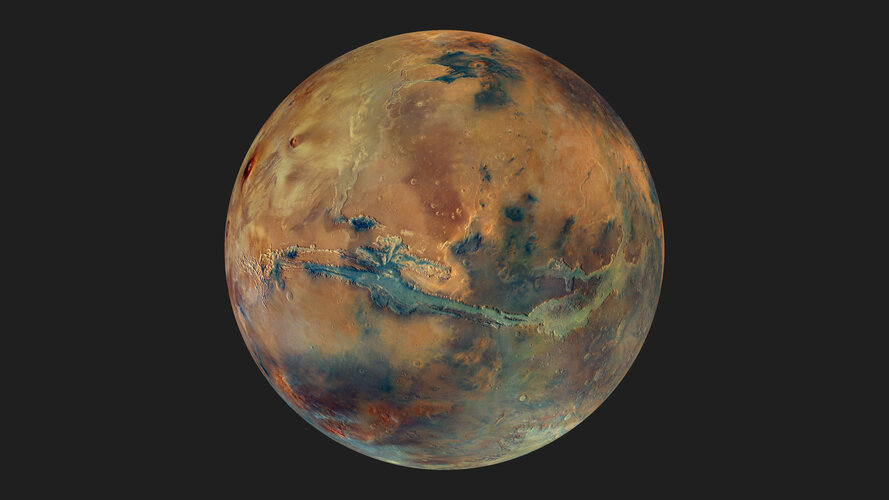
12 November 2024 marks the start of a new year on Mars. At exactly 10:32 CET/09:32 UTC on Earth, the Red Planet begins a new orbit around our Sun.
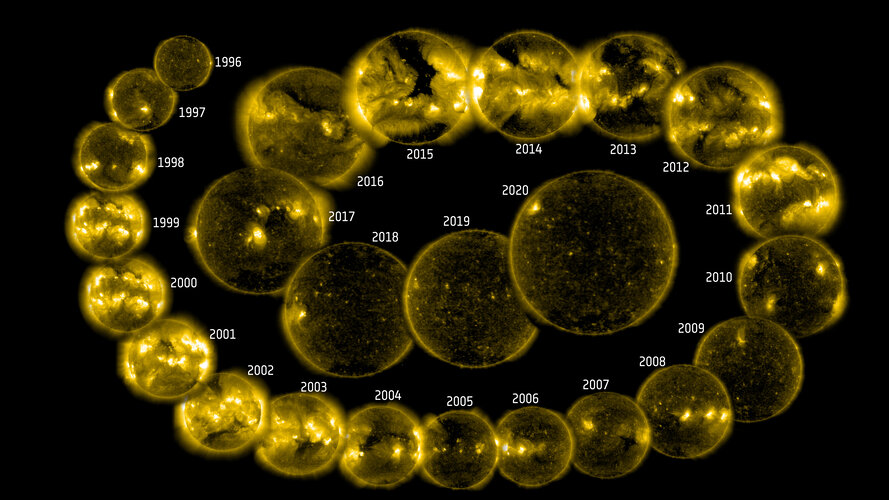
The Sun follows a roughly 11-year rhythm of waking up and becoming very active before calming down again, a stellar beat known as the solar cycle. This affects Earth because it shapes space weather, determining how much radiation, magnetic field and particles the Sun flings out into space and towards our planet.
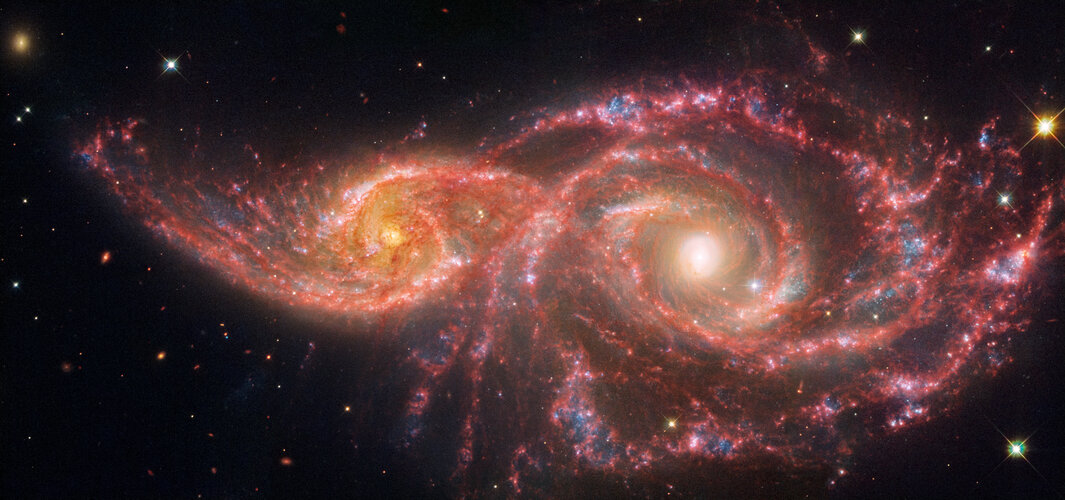
Stare deeply at these galaxies. They appear as if blood is pumping through the top of a flesh-free face. The long, ghastly ‘stare’ of their searing eye-like cores shines out into the supreme cosmic darkness.
 Image:
Image:
The construction phase of ESA’s Ariel mission has started at Airbus Defence and Space in Toulouse (France) with the assembly of the spacecraft’s structural model. This marks a significant step forward for this mission designed to meticulously inspect the atmospheres of a thousand exoplanets and uncover their nature.
In the image we see Ariel’s structural model coming together at the Airbus facilities. This model replicates the mechanical framework of the spacecraft and the mass of its various units for a first round of tough testing.
The Ariel’s structural model consists of two main components: a flight-like replica of the service module (bottom right) and a simplified mechanical mock-up of the payload module (top right). This assembly mimics the structure of the flight spacecraft, where the science instruments make up the payload while the service module houses the essential components for the functioning of the spacecraft, such as the propulsion, and the power and communication systems.
The goal for the end of the year is to complete the mechanical test campaign of the spacecraft’s structural model. This will ensure that Ariel’s design is up-to-spec and can withstand the mechanical strains expected during launch.
The testing phase will include vibration and acoustic test campaigns. During vibration tests the model will be progressively shaken at different strengths on a vibrating table, or 'the shaker'. During acoustic tests, it will be placed in a reverberating chamber and ‘bombarded’ with very intense noise, like it will encounter during launch.
This model will also be used to assess how the loads are distributed and to perform a first ‘separation and shock’ test using the same mounting system as will be used to mount the spacecraft on the Ariane 6.
When ready, Ariel will be launched by an Ariane 6.2 rocket and journey to the second Lagrangian Point from where it will carry out its uniquely detailed studies of remote worlds.
Image description: A collage of three photographs that show the assembly of the model of a spacecraft in a large white hall. The first image on the left shows the entire model, with a person next to it who is nearly equal in height. The second image on the upper right zooms in on the top part of the mock science instrument: a circular fan-like structure with a big rectangular silver box on top. The third image on the lower right focuses on the bottom of the model, which looks like a large round silver box.
 Video:
00:00:23
Video:
00:00:23
From 7 until 13 October 2024, ESA/NASA’s SOHO spacecraft recorded Comet C/2023 A3 (Tsuchinshan–ATLAS), the second brightest comet it has ever seen. Meanwhile, large amounts of material were being spewed out by the Sun (covered in the centre), and planet Mercury is visible to the left.
The comet’s nucleus is clearly visible, surrounded by a dusty coma and trailing an impressively long tail. SOHO sees the large dust tail edge-on, curving in on itself as it is pushed outward by solar wind.
At the end of the video you can also see a rare phenomenon known as an ‘anti-tail’: a long, thin line that points towards the Sun. This tail is an optical illusion coming from SOHO getting an edge-on view of the larger cometary dust particles that accumulate in the comet’s orbital plane.
Comet C/2023 A3 was seen for the first time early last year. It most likely came from the distant Oort cloud.
The comet reached an estimated peak brightness just beyond –4 magnitude. (The more negative the visual magnitude value, the brighter the object.) Of the more than 5000 comets SOHO has seen flying past the Sun, only Comet C/2006 P1 (McNaught) was brighter, with a visual magnitude of –5.5.
SOHO’s location between the Sun and Earth gave it a front-row seat, but the same comet has been visible from Earth every evening since 12 October 2024. Throughout October, as the comet moves farther away from the Sun, it will gradually grow fainter and rise higher up in the western sky.
The week that SOHO watched Comet Tsuchinshan–ATLAS was also a wild one in terms of space weather. The Sun unleashed no less than 4 X-class flares (the highest intensity type of flare), 28 medium-intensity M-class flares, and 31 coronal mass ejections – the latter being visible as white clouds of material in the video. All this activity led to two geomagnetic storms on Earth, resulting in beautiful auroras lighting up the night sky.
SOHO, short for Solar and Heliospheric Observatory, is a joint ESA-NASA mission to study the Sun. For almost 29 years now, it has been watching the Sun itself as well as the much fainter light coming from the Sun’s outer atmosphere, called the solar corona. The data shown in this video were taken by the LASCO C3 coronagraph instrument.
Special thanks to Simeon Schmauß, who processed the raw data to create this impressive video. For comparison, here is a video of the comet with more standard data processing – the comet is so bright that it partially saturated SOHO’s sensor.
What types of comets are there?
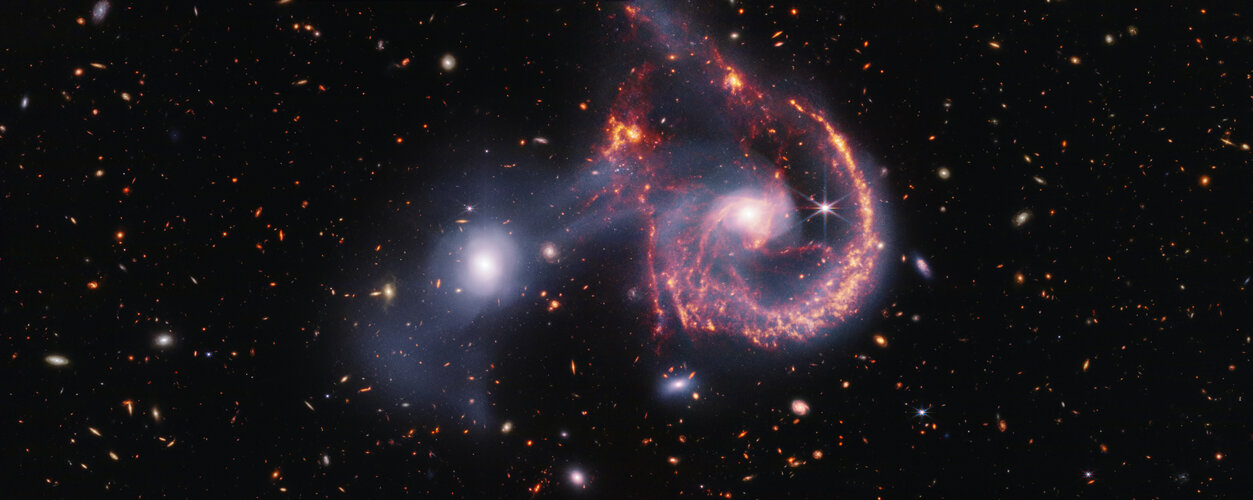 Image:
Webb’s new view of Arp 107
Image:
Webb’s new view of Arp 107
 Video:
00:01:15
Video:
00:01:15
See Mercury in a whole new light, through the ‘eyes’ of the ESA/JAXA BepiColombo spacecraft, as it sped past Mercury during its latest encounter on 4 September 2024.
During the flyby, BepiColombo’s three monitoring cameras (M-CAMs) captured detailed images of the planet’s cratered surface. Within these images, Mercury scientists identified various geological features that BepiColombo will study in more detail once in orbit around the planet.
One such feature, shown in this video, is the newly named Stoddart crater. The name ‘Stoddart’ – after artist Margaret Olrog Stoddart (1865–1934) – was recently assigned following a request from the M-CAM team, who realised that this crater would be visible in these images and decided it would be worth naming considering its potential interest for scientists in the future.
Stoddart is a special type of crater called a ‘peak ring basin’. These mysterious craters are created by powerful asteroid or comet impacts, and are named after the inner ring of peaks on an otherwise flattish floor.
The video then pans around to the larger Raphael crater. Many newer craters dot the surface and walls of Raphel, giving an indication of Mercury’s violent history.
At the end of the video the camera zooms out to put the region into perspective.
The 3D scene was reconstructed from a single image using the ‘Shape from Shading’ method. Shape from Shading uses a reflectance model to render an artificial image of the surface from an initial 3D model. This render is compared to the original image, and the 3D model is subsequently improved to minimise the difference between the images. The heights in the video are not to scale. The flyover was created in Unity.
The 4 September gravity assist flyby was the fourth at Mercury and the seventh of nine planetary flybys overall. During its eight-year cruise to the smallest and innermost planet of the Solar System, BepiColombo makes one flyby at Earth, two at Venus and six at Mercury, to help steer itself on course for entering orbit around Mercury in 2026.
BepiColombo is an international collaboration between ESA and JAXA.
BepiColombo’s best images yet highlight fourth Mercury flyby
BepiColombo images in ESA’s Planetary Science Archive
 Image:
Digel Cloud 2S
Image:
Digel Cloud 2S
 Image:
Image:
During its recent flyby of Earth, ESA's Jupiter Icy Moons Explorer (Juice) travelled through the zones of charged particles that surround our planet. These two zones are known as the Van Allen radiation belts. The inner belt is mostly full of energetic protons, and the outer belt is mostly full of energetic electrons. The region between the two belts is mostly empty.
The high levels of radiation in the Van Allen belts makes them very dangerous for electronics and humans, but they pale in comparison to Jupiter's own radiation belts. At Jupiter, extremely energetic electrons can get through even the thickest of shielding, so they could damage Juice's scientific instruments over time.
Juice carries a radiation monitor called RADEM to continuously measure the spacecraft's exposure to high-energy particles. RADEM forms part of a long-term plan to better understand radiation throughout the Solar System, and supplements Juice's Plasma Environment Package – a collection of sensors designed to measure charged particles around Jupiter and its icy moons.
Juice's flight through the Van Allen belts was RADEM's first big test in space. It passed with flying colours, successfully measuring electrons in the outer belt, then protons in the inner belt, then electrons again as it moved away from Earth. The blue and yellow dots indicate the intensity of electrons and protons that Juice measured; in both cases the intensity peaks as Juice goes through the densest part of the belt.
These observations demonstrated the capabilities of RADEM and provided a great opportunity to cross-calibrate the instrument with other spacecraft orbiting Earth in a well-known environment.
More about Juice's lunar-Earth flyby
More about Juice's instruments
RADEM was built in Portugal by Efacec in collaboration with the Laboratory for Instrumentation and Experimental Particle Physics, the Paul Scherrer Institute and Integrated Detector Electronics.
[Image description: Black background with planet Earth at the centre. We see a spacecraft travelling around Earth from right to left. Concentric white circles surround Earth, indicating distance. It is possible to move a slider to switch between two images that both have all of the aforementioned elements. The left image shows a ring of white closely surrounding Earth; blue dots (protons) are plotted along Juice's trajectory, peaking where Juice travels through this white band. The right image shows a ring of white further from Earth; yellow dots (electrons) are plotted along Juice's trajectory, peaking in the two places where Juice travels through this white band.]
 Image:
Webb peeks into Perseus
Image:
Webb peeks into Perseus